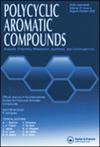Design and Synthesis of Some New Quinoxaline-1,2,4-Oxadiazole-Amide Conjugates as EGFR Targeting Agents and ADMET Studies
IF 2.4
3区 化学
Q2 CHEMISTRY, ORGANIC
引用次数: 0
Abstract
The synthesis of some new quinoxaline-1,2,4-oxadiazole-amide conjugates (6a–n) was described, and their structures were determined using 1HNMR, 13CNMR, and mass spectral analysis. The in vitro anti-cancer activity of the compounds (6a–n) against three human cancer cell lines such as MCF-7 (breast), HepG2 (lung), and DU-145 (prostate) revealed that the compounds 6d, 6e, and 6f exhibited promising activity against three cancer cell lines. Predominantly, compound 6f demonstrated greater activity than the standard drug Etoposide on MCF-7, HepG2, and DU-145 with IC50 values of 0.82 ± 0.01, 1.30 ± 0.02, and 2.12 ± 0.04 µM, respectively. Furthermore, the compounds 6e and 6f displayed promising inhibitory activity over the tyrosine kinase EGFR when compared with the standard Erlotinib. Molecular docking studies carried out on three potent compounds (6d, 6e, and 6f) on the EGFR receptor recommended that the compound 6f strongly binds to protein EGFR (pdbid: 4HJO). In addition, the in silico pharmacokinetic profile was also achieved for the three potent compounds 6d, 6e, and 6f using SWISS/ADME and pk CSM. Results showed that the compounds 6d, 6e, and 6f followed the Lipinski rule, Veber rule, Egan rule, Ghose rule, and Muegge rule without any deviation.
作为表皮生长因子受体靶向药物的新型喹喔啉-1,2,4-恶二唑-酰胺共轭物的设计与合成以及 ADMET 研究
研究人员合成了一些新的喹喔啉-1,2,4-恶二唑-酰胺共轭物(6a-n),并利用 1HNMR、13CNMR 和质谱分析确定了它们的结构。化合物(6a-n)对三种人类癌症细胞系,如 MCF-7(乳腺癌)、HepG2(肺癌)和 DU-145(前列腺癌)的体外抗癌活性表明,化合物 6d、6e 和 6f 对三种癌症细胞系具有良好的活性。其中,化合物 6f 对 MCF-7、HepG2 和 DU-145 的活性高于标准药物依托泊苷,IC50 值分别为 0.82 ± 0.01、1.30 ± 0.02 和 2.12 ± 0.04 µM。此外,与标准药物厄洛替尼相比,化合物 6e 和 6f 对酪氨酸激酶表皮生长因子受体具有良好的抑制活性。对三种强效化合物(6d、6e 和 6f)进行的表皮生长因子受体分子对接研究表明,化合物 6f 能与表皮生长因子受体蛋白(pdbid: 4HJO)紧密结合。此外,还利用 SWISS/ADME 和 pk CSM 对 6d、6e 和 6f 这三种强效化合物的药代动力学特征进行了硅学研究。结果表明,6d、6e 和 6f 遵循 Lipinski 规则、Veber 规则、Egan 规则、Ghose 规则和 Muegge 规则,没有出现任何偏差。
本文章由计算机程序翻译,如有差异,请以英文原文为准。
求助全文
约1分钟内获得全文
求助全文
来源期刊

Polycyclic Aromatic Compounds
化学-有机化学
CiteScore
3.70
自引率
20.80%
发文量
412
审稿时长
3 months
期刊介绍:
The purpose of Polycyclic Aromatic Compounds is to provide an international and interdisciplinary forum for all aspects of research related to polycyclic aromatic compounds (PAC). Topics range from fundamental research in chemistry (including synthetic and theoretical chemistry) and physics (including astrophysics), as well as thermodynamics, spectroscopy, analytical methods, and biology to applied studies in environmental science, biochemistry, toxicology, and industry. Polycyclic Aromatic Compounds has an outstanding Editorial Board and offers a rapid and efficient peer review process, as well as a flexible open access policy.
 求助内容:
求助内容: 应助结果提醒方式:
应助结果提醒方式:


